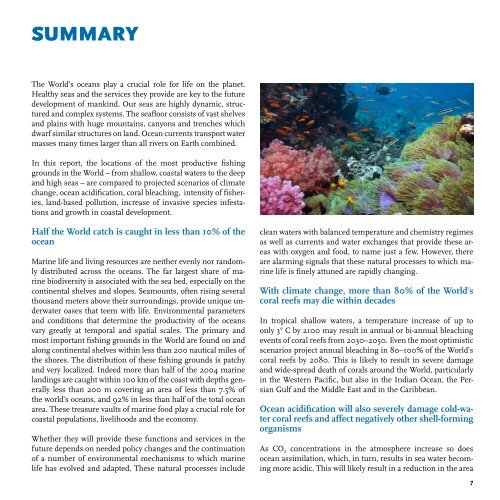In Dead Water: Merging of climate change with - UNEP
In Dead Water: Merging of climate change with - UNEP
In Dead Water: Merging of climate change with - UNEP
Create successful ePaper yourself
Turn your PDF publications into a flip-book with our unique Google optimized e-Paper software.
SUMMARY<br />
The World’s oceans play a crucial role for life on the planet.<br />
Healthy seas and the services they provide are key to the future<br />
development <strong>of</strong> mankind. Our seas are highly dynamic, structured<br />
and complex systems. The seafloor consists <strong>of</strong> vast shelves<br />
and plains <strong>with</strong> huge mountains, canyons and trenches which<br />
dwarf similar structures on land. Ocean currents transport water<br />
masses many times larger than all rivers on Earth combined.<br />
<strong>In</strong> this report, the locations <strong>of</strong> the most productive fishing<br />
grounds in the World – from shallow, coastal waters to the deep<br />
and high seas – are compared to projected scenarios <strong>of</strong> <strong>climate</strong><br />
<strong>change</strong>, ocean acidification, coral bleaching, intensity <strong>of</strong> fisheries,<br />
land-based pollution, increase <strong>of</strong> invasive species infestations<br />
and growth in coastal development.<br />
Half the World catch is caught in less than 10% <strong>of</strong> the<br />
ocean<br />
Marine life and living resources are neither evenly nor randomly<br />
distributed across the oceans. The far largest share <strong>of</strong> marine<br />
biodiversity is associated <strong>with</strong> the sea bed, especially on the<br />
continental shelves and slopes. Seamounts, <strong>of</strong>ten rising several<br />
thousand meters above their surroundings, provide unique underwater<br />
oases that teem <strong>with</strong> life. Environmental parameters<br />
and conditions that determine the productivity <strong>of</strong> the oceans<br />
vary greatly at temporal and spatial scales. The primary and<br />
most important fishing grounds in the World are found on and<br />
along continental shelves <strong>with</strong>in less than 200 nautical miles <strong>of</strong><br />
the shores. The distribution <strong>of</strong> these fishing grounds is patchy<br />
and very localized. <strong>In</strong>deed more than half <strong>of</strong> the 2004 marine<br />
landings are caught <strong>with</strong>in 100 km <strong>of</strong> the coast <strong>with</strong> depths generally<br />
less than 200 m covering an area <strong>of</strong> less than 7.5% <strong>of</strong><br />
the world’s oceans, and 92% in less than half <strong>of</strong> the total ocean<br />
area. These treasure vaults <strong>of</strong> marine food play a crucial role for<br />
coastal populations, livelihoods and the economy.<br />
Whether they will provide these functions and services in the<br />
future depends on needed policy <strong>change</strong>s and the continuation<br />
<strong>of</strong> a number <strong>of</strong> environmental mechanisms to which marine<br />
life has evolved and adapted. These natural processes include<br />
clean waters <strong>with</strong> balanced temperature and chemistry regimes<br />
as well as currents and water ex<strong>change</strong>s that provide these areas<br />
<strong>with</strong> oxygen and food, to name just a few. However, there<br />
are alarming signals that these natural processes to which marine<br />
life is finely attuned are rapidly changing.<br />
With <strong>climate</strong> <strong>change</strong>, more than 80% <strong>of</strong> the World’s<br />
coral reefs may die <strong>with</strong>in decades<br />
<strong>In</strong> tropical shallow waters, a temperature increase <strong>of</strong> up to<br />
only 3° C by 2100 may result in annual or bi-annual bleaching<br />
events <strong>of</strong> coral reefs from 2030–2050. Even the most optimistic<br />
scenarios project annual bleaching in 80–100% <strong>of</strong> the World’s<br />
coral reefs by 2080. This is likely to result in severe damage<br />
and wide-spread death <strong>of</strong> corals around the World, particularly<br />
in the Western Pacific, but also in the <strong>In</strong>dian Ocean, the Persian<br />
Gulf and the Middle East and in the Caribbean.<br />
Ocean acidification will also severely damage cold-water<br />
coral reefs and affect negatively other shell-forming<br />
organisms<br />
As CO2 concentrations in the atmosphere increase so does<br />
ocean assimilation, which, in turn, results in sea water becoming<br />
more acidic. This will likely result in a reduction in the area

















